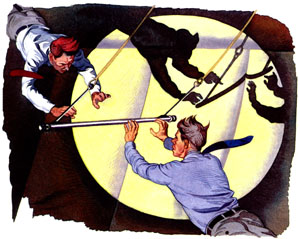
Merging High And Low
Ten Years Of Growing Together - 1995 - AT&T Capital Corporation
Physically, they were separated by only a single hallway. But culturally, they were civilizations dwelling on opposite sides of the earth, driven by different customer needs and vastly different experiences. Fundamentally, they didn't understand each other and, to a great degree, they didn't trust each other, either.
While the big-ticket, low-volume Business Markets Division (BMD) had changed several of its processes, it had never gone through the kind of refining fire that had created the dramatic changes in the high-volume General Markets Division (GMD) business. BMD had its own system.
BMD emphasized personal relationships with customers and an in-depth knowledge of every deal. Its people lived in high-walled cubicles for quiet and privacy. Information systems were simple - in most cases, customer information was stored on index cards.
When BMD moved into the Washington Office Center not long after the high-volume team did, the groups' reactions to one another were not unlike two antagonistic neighbor states meeting for the first time across a demilitarized zone.
"We used to call the hall between us the 'hall of knowledge,'" one GMD member says. "It was always a mystery exactly what high-volume was and what it did," a BMD member recalls.
But while the gap between the two was wide, the needs of their customers were converging. Small customers wanted more that fast service, and large customers were growing interested in fast turnaround time.
Other things had changed dramatically as well. The high-volume business, once perceived as the poor step child of the economy, had, in fact, become the profit engine. Net income for the group had gone from a loss in 1986 to a profit in 1989. All of this was attributed mainly to its innovative organizational design. Almost overnight the world had changed, and the rumor that swept through the halls was that more change was on its way. It consisted of a single word: merger.
This time the changes would take two years. The merger of high and low volume and the creation of a design team was announced at a combined meeting of both groups on Valentine's Day 1989. Anyone could join the team. Initial applications consisted of a written essay about the concept of high-performance teams in general. Those who made the first cut then went through the interview process. Those who made it through the interview were part of the team.
Arlene Sena was one of the 13 members chosen. "I thought it was an enormous project," she says. "I also thought that the two groups were so different that we would never bring them together. From the outset, it looked like a no-win situation. But I remember we thought it was a good learning opportunity."
Marybeth Haggerty, a unit facilitator who rolled out the new design, remembers the kick-off meeting and how the mutual distrust began to dissolve: "Our biggest challenge was to turn the two cultures into a single cohesive team.
Once people started relating to one another as individuals, not just as part of separate groups, things were easier."
The initial work of the design team consisted of analyzing how things already worked. They conducted an environmental scan, looking at customer requirements, work processes, and the social interactions within each organization. A typical day consisted of two-person interview teams who examined work flows, discovering what people actually did, and then asked whether the people liked what they were doing. Later, the team would expand its research into surveys that covered all 400 to 500 members.
It was the first chance they had, as one team member put it, to crawl through the company and have everybody tell them everything they could about how it really worked.
Reactions to what they were doing ranged all over the map. "I think about half the people thought we didn't have any answers at all, others thought we already had our minds made up, and everybody else thought we were hiding something from them," Arlene says. "The trust level within the two organizations was not high."
To counteract that, the team went out of its way to keep the members informed. A phone extension was set up so members could get updates on the team's findings, and there were regularly scheduled breakfast and lunch meetings so that members could talk directly with the team.
Marybeth Haggerty recalls, "It was a difficult time for everyone because our roles were changing, and we were searching for the right balance. At the same time, we were still trying to get the work out."
By the time the research phase was completed nine and a half months later, the results were massive: Arlene's work alone filled six large binders.
Once the analysis was completed, the team retreated to Lake George, N.Y., and faced its final task: creating the new system. A few days into the process, some team members thought it couldn't be done. There were just too many differences of opinion within the design team itself. But by the end, the differences were gone, and the new structured emerged.
The team's new system would be ruled by a single, overriding principle: The organization should be driven by the need to serve the customer.
"The high- and low-volume businesses were combined into self-contained and self-directed units in four regional centers," Arlene says. "The units were small, maybe 20 members each, and each unit had a facilitator whose main role was to help unit members become self-directed teams. We wanted to broaden responsibility, minimize the amount of documentation that had to be handed off, and keep members as close to the customer as possible. The small-team concept made that possible."
In addition to the regional centers, there were profit-and-loss centers created for the state and local government business, another for the federal government, and a specialty center for various businesses that didn't fit into the standard customer profile - emerging businesses not yet financially stable or those with limited growth potential, for example.
This article was featured in Ten Years of Growing Together. Physical layouts would change as well. The unit leader's office would become a cubicle with glass walls, for symbolic as well as practical reasons. Formerly, members felt they couldn't communicate easily with the leadership behind closed doors. The glass walls served as a kind of metaphor for open, two-way communication.
Some changes were subject to rapid change themselves. For example, a single account manager position was created from the old sales support, contract, funding, and contract manager positions in GMD and BMD. But when the change went into effect, it didn't work as well as planned. So it was changed again. The single manager's position was split into two separate roles, one with responsibility for high volume and one for low volume.
The design team also allowed for individual choices. "Each member had several options for how his or her cubicle was set up. That allowed them, to a certain degree, to personalize their workspace," Arlene says. In the end, despite all the preliminary work and careful planning, feelings about the changes were mixed. "That's just human nature. Some liked it, some didn't," Arlene recalls. "But two important things emerged from what we did. One, we made the change without affecting our customers. Many of them didn't even know it was going on. Two, everybody pulled together, and it worked."
The learning curve lasted six months and showed impressive results. There was a substantial decline in delinquency rates in the three years following the system redesign. During that same period, return on equity for the combined units grew as well.
When it was all over, a videotape was produced that allowed the design-team members to talk about what they'd done and how they felt about it. The videotape later became part of the standard tour package when other businesses came to see and learn from what the team had done.
"I remember when Salomon Brothers came through and watched the videotape," Arlene says. "When it was over, one of them said to me, 'You know, you really did something phenomenal here.' I'd never thought about it while we in the middle of it. But when he said that, I finally realized that, yes, we had accomplished something good."


